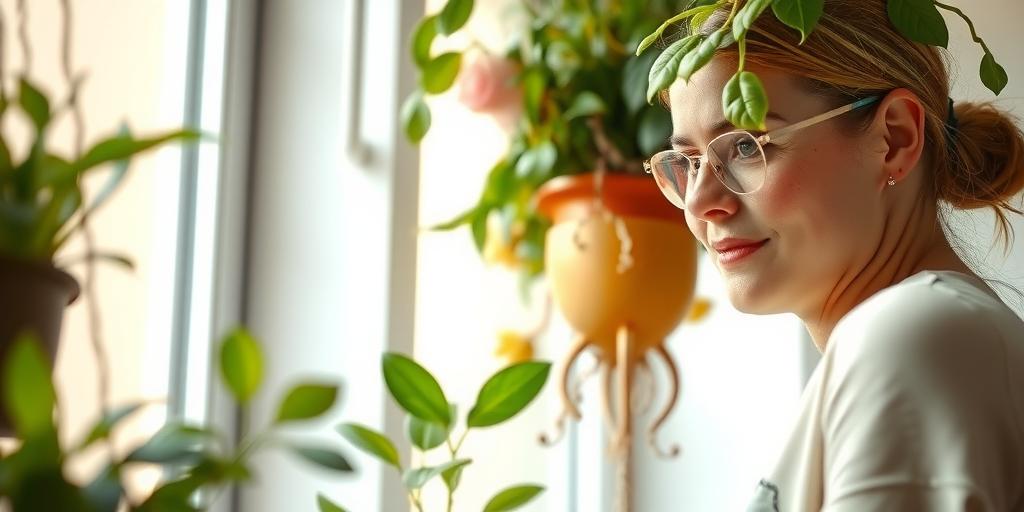
How to Prevent Root Rot in Low Light Hanging Plants: A Complete Guide
Learn how to prevent root rot in low light hanging plants with expert tips on watering, soil selection, and proper care. Keep your indoor greenery thriving!
Introduction
Do your hanging plants struggle with root rot despite being in low-light spaces? You’re not alone! Root rot is a common issue for indoor plants, especially those in dimly lit areas where moisture lingers too long. But don’t worry—with the right care, you can save your plants and keep them healthy. In this guide, we’ll cover everything from choosing the right soil to perfecting your watering routine. Let’s dive in and rescue those roots!
Understanding Root Rot in Low Light Conditions
What Causes Root Rot in Low Light Hanging Plants?
Root rot is a common issue for hanging plants, especially in low light conditions. The main culprit? Overwatering combined with poor drainage. When plants don’t get enough light, their growth slows down, meaning they take up water at a much slower rate. Excess moisture lingers in the soil, creating the perfect breeding ground for fungi like Pythium and Phytophthora, which attack the roots.
How Does Poor Lighting Contribute to Excess Moisture and Fungal Growth?
Low light means less photosynthesis, which reduces the plant’s water needs. When you water a low light plant as frequently as one in bright light, the soil stays wet for too long. This damp environment suffocates the roots, cutting off oxygen and encouraging fungal infections. Essentially, the plant can’t “drink” fast enough, leading to waterlogged soil—a death sentence for delicate roots.
Early Signs of Root Rot (Yellowing Leaves, Mushy Stems, Foul Odor)
Catching root rot early is key to saving your plant. Watch for:
-
Yellowing leaves – Often starts at the lower leaves and moves upward.
-
Mushy stems – A sign that the roots are no longer supplying nutrients properly.
-
Foul odor – Rotten roots emit a distinct, unpleasant smell from the soil.
-
Wilting despite wet soil – If the plant droops but the soil is damp, root rot is likely the issue.
Choosing the Right Soil for Drainage
Best Soil Mixes for Low Light Hanging Plants (Perlite, Orchid Bark, Coco Coir)
The right soil mix can make or break your hanging plant’s health. Opt for lightweight, well-draining blends like:
-
Perlite – Adds air pockets to prevent compaction.
-
Orchid bark – Improves drainage and mimics natural forest floor conditions.
-
Coco coir – Retains some moisture without becoming waterlogged.
A great DIY mix? Combine equal parts potting soil, perlite, and orchid bark for a balanced, breathable medium.
Why Heavy Potting Soil Is a No-Go for Hanging Plants
Standard potting soil is often too dense for hanging plants, especially in low light. It retains moisture for too long, increasing the risk of root rot. Heavy soil also adds unnecessary weight to hanging planters, which can strain hooks or brackets. Always lighten it up with amendments like perlite or sand.
How to Test Soil Drainage Before Planting
Before committing to a soil mix, do a quick drainage test:
-
Moisten the soil as if you’ve just watered it.
-
Squeeze a handful—if water streams out or it feels soggy, it’s too dense.
-
Ideal soil should hold slight moisture but crumble easily when touched.
Watering Techniques to Prevent Root Rot
How Often to Water Low Light Hanging Plants (Less Is More!)
Low light = less water. A good rule of thumb:
-
Let the soil dry out between waterings—stick to a schedule of every 10–14 days, but always check the soil first.
-
Smaller pots dry faster, so adjust accordingly.
The Finger Test: Checking Soil Moisture Before Watering
Skip the guesswork with the finger test:
-
Insert your finger 1–2 inches into the soil.
-
If it feels dry, water lightly. If damp, wait a few more days.
-
For deeper pots, use a chopstick—if it comes out clean, it’s time to water.
Using Self-Watering Pots or Moisture Meters for Precision
For forgetful plant parents, tools can help:
-
Self-watering pots – Provide consistent moisture without overdoing it.
-
Moisture meters – Take the guesswork out of watering by measuring soil dampness.
Selecting the Best Hanging Plants for Low Light
Top Low Light Hanging Plants Resistant to Root Rot
Some plants are naturally hardier in low light and less prone to root rot:
-
Pothos – Thrives in neglect and bounces back easily.
-
Spider Plant – Tolerates irregular watering and low light.
-
Philodendron – Adaptable and forgiving for beginners.
How to Match Plant Choices with Your Home’s Lighting Conditions
Assess your space:
-
North-facing windows – Ideal for low light plants like pothos.
-
Filtered light areas – Try ferns or philodendrons.
-
Dark corners – Stick to ultra-tolerant species like ZZ plants (though not typically hanging).
Signs Your Plant Isn’t Getting Enough Light (And How to Fix It)
If your plant shows:
-
Leggy growth – Stems stretching toward light.
-
Small, pale leaves – Lack of energy for proper growth.
-
Slow or no growth – The plant is barely surviving.
Fix it by: Moving it closer to a light source (even artificial light helps) or rotating it weekly for even exposure.
Improving Airflow and Humidity Control
Why Stagnant Air Worsens Root Rot in Hanging Plants
Still air traps moisture around leaves and soil, speeding up fungal growth. Hanging plants are especially vulnerable because they’re often placed in corners or high spots where air doesn’t circulate well.
Simple Ways to Increase Airflow Around Plants
-
Use a small fan – Set it on low nearby to mimic a gentle breeze.
-
Open windows – Even briefly can refresh the air.
-
Space plants apart – Avoid clustering too many together.
Balancing Humidity Levels for Optimal Plant Health
Most low light plants prefer 40–60% humidity. Too dry? Use a pebble tray or humidifier. Too damp? Improve ventilation or run a dehumidifier.
Repotting and Root Rescue Tips
When and How to Repot a Plant with Root Rot
Repot immediately if:
-
The plant is declining despite proper care.
-
Roots are brown, mushy, or smell bad.
Steps:
-
Gently remove the plant and shake off old soil.
-
Trim rotten roots (more below).
-
Repot in fresh, well-draining mix.
Step-by-Step Guide to Trimming Rotten Roots Safely
-
Sterilize scissors/shears with rubbing alcohol.
-
Cut away black or mushy roots until only firm, white roots remain.
-
Dust with cinnamon (a natural antifungal) to prevent reinfection.
Best Practices for Disinfecting Pots and Tools
-
Scrub pots with hot, soapy water.
-
Soak in a bleach solution (1 part bleach to 9 parts water) for 10 minutes.
-
Rinse thoroughly before reuse.
By following these steps, you can rescue your plant and create a healthier environment to prevent future root rot.
Conclusion
Root rot doesn’t have to spell the end for your low light hanging plants! By choosing the right soil, watering wisely, and ensuring proper airflow, you can keep your greenery lush and healthy. Remember—prevention is easier than cure, so stay proactive with your plant care routine. Ready to give your hanging plants the love they deserve? Start implementing these tips today!
